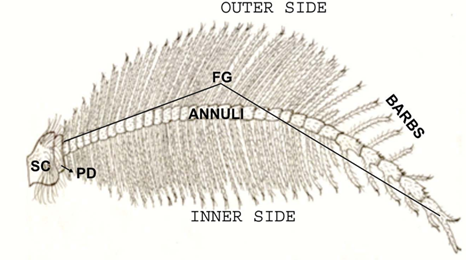P-ISSN: 2349-6800, E-ISSN: 2320-7078
Journal of Entomology and Zoology Studies
2014, Vol. 2, Issue 4
Sex Specificity of Antennal Sensilla in Eri Silkworm Philosamia ricini
Deepak Barsagade, Arun Khurad, Mina Chamat, Hemraj Meshram, Manoj Thakre, Shruti Gharade, Ganesh Gathalkar and Rani Thakre
The antennae of both sexes of eri silk moth Philosamia ricini were examined using scanning electron microscopy. The antennae are bipectinate type segmented consisting of scape, pedicel and flagellum. The flagellum consists of about 32 similar segments known as annuli. Different types of sensilla are present on the scape, pedicel and flagellum functioning as a sensory perception. Böhm bristle and sensilla trichoidea are found on scape and pedicel. The flagellum consists of sensilla chaetica (SCH), sensilla trichoidea (ST), sensilla trichoidea curvata (STC), sensilla basiconica (SB), sensilla squamiformia (SQU) and sensilla styloconica (SS). Sensilla trichoidea is further divided into sensilla trichoidea-I (ST-I), sensilla trichoidea-II (ST-II) and sensilla trichoidea- III (ST-III). The flagellum contains SCH, ST-II, ST-III, STC, SB, SQU and SS in female and SCH, ST-I, ST-II, ST-III, STC, SB, SQU and SS in male. ST-I sensilla is sex specific and present on male antenna.

Fig. 1: Female antenna (diagrammatic).
Pages : 206-211 | 1652 Views | 131 Downloads
How to cite this article:
Deepak Barsagade, Arun Khurad, Mina Chamat, Hemraj Meshram, Manoj Thakre, Shruti Gharade, Ganesh Gathalkar, Rani Thakre. Sex Specificity of Antennal Sensilla in Eri Silkworm Philosamia ricini. J Entomol Zool Stud 2014;2(4):206-211.
Related Journal Subscription
Important Publications Links
Important Links










